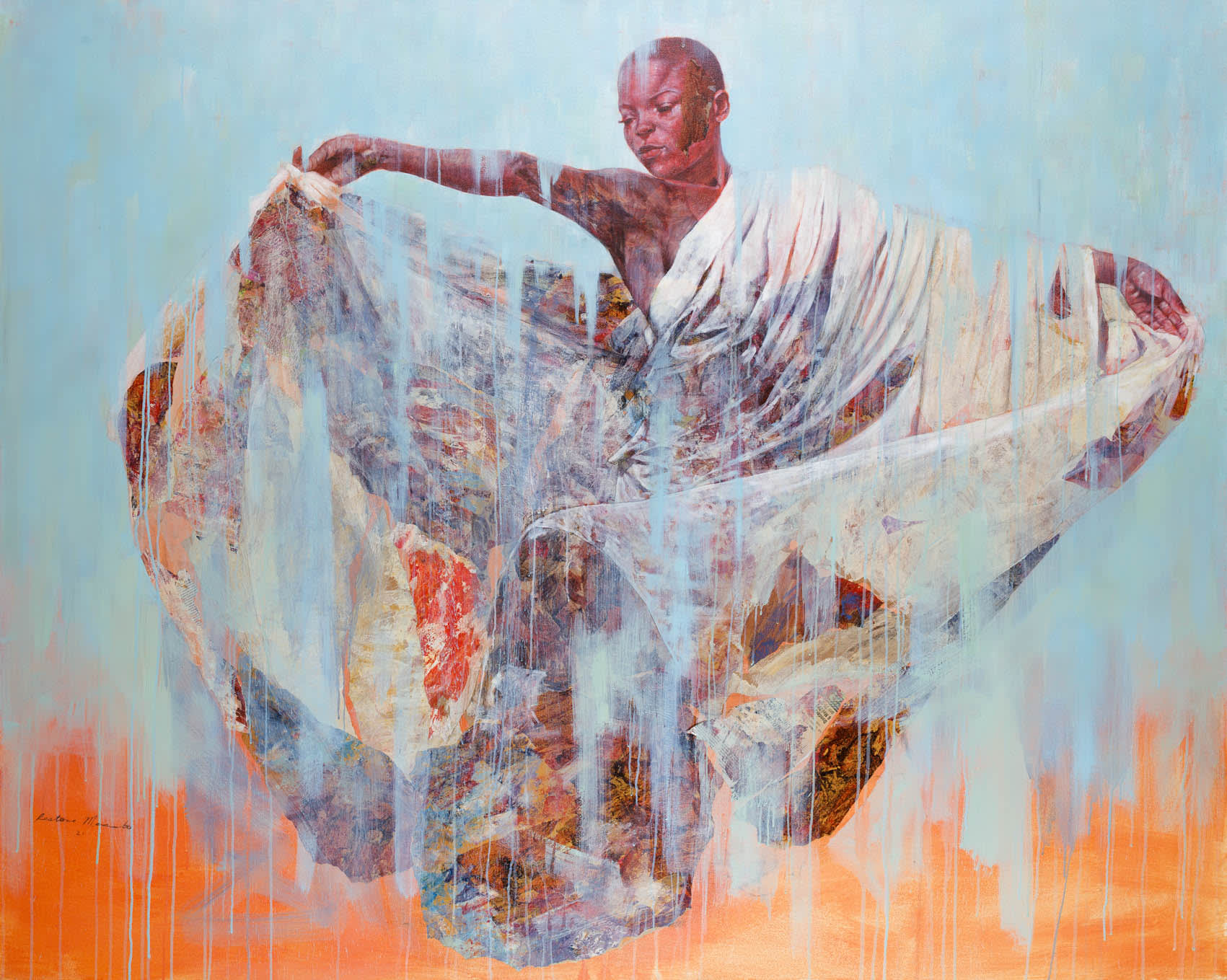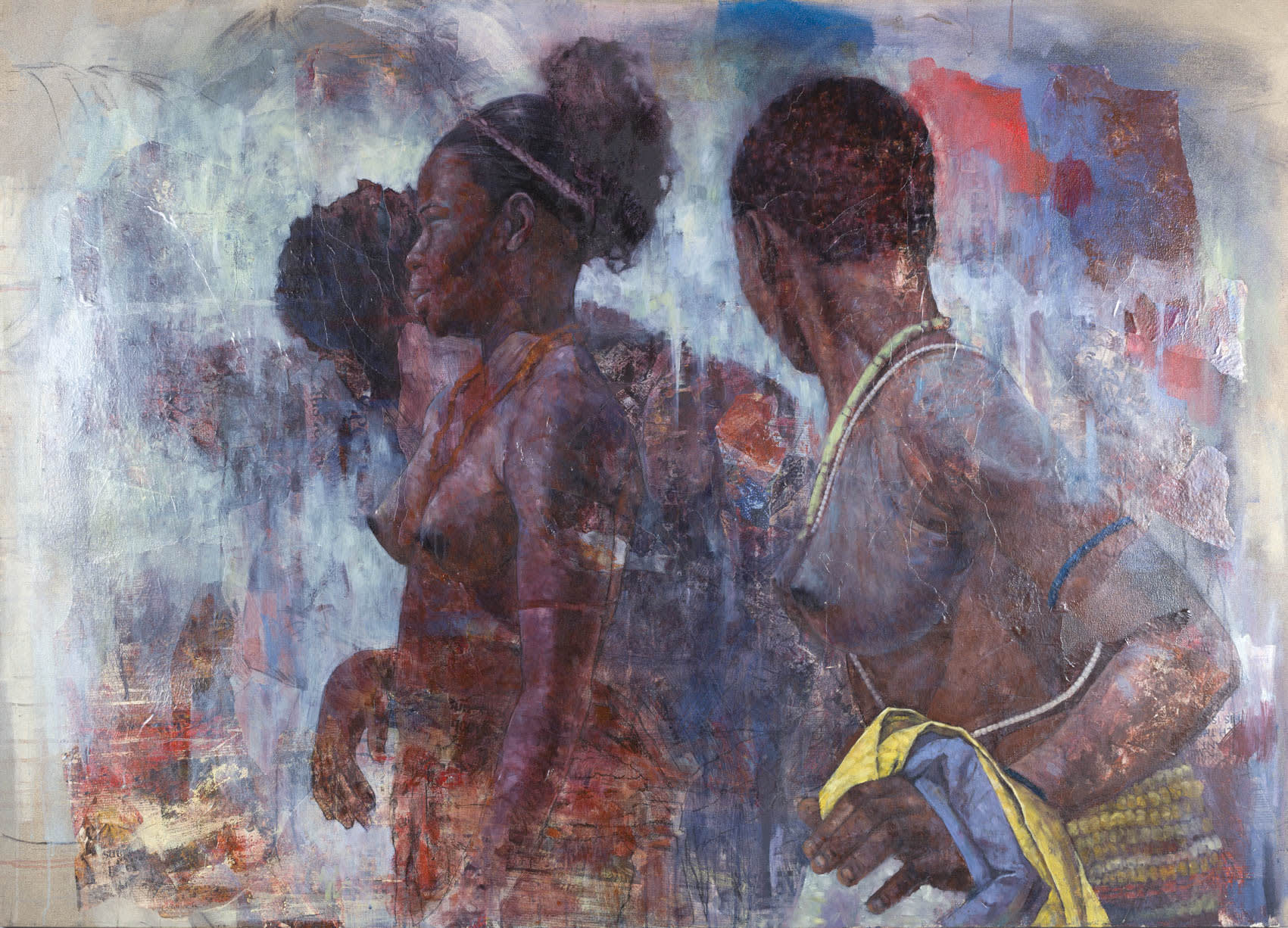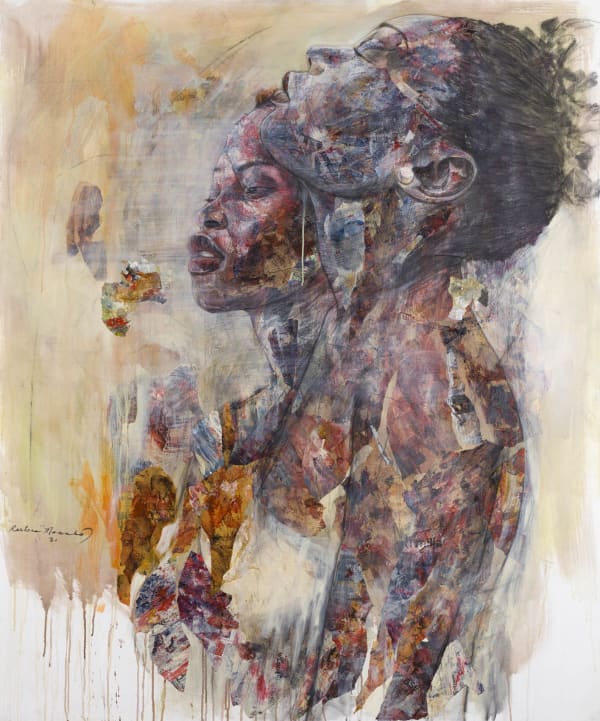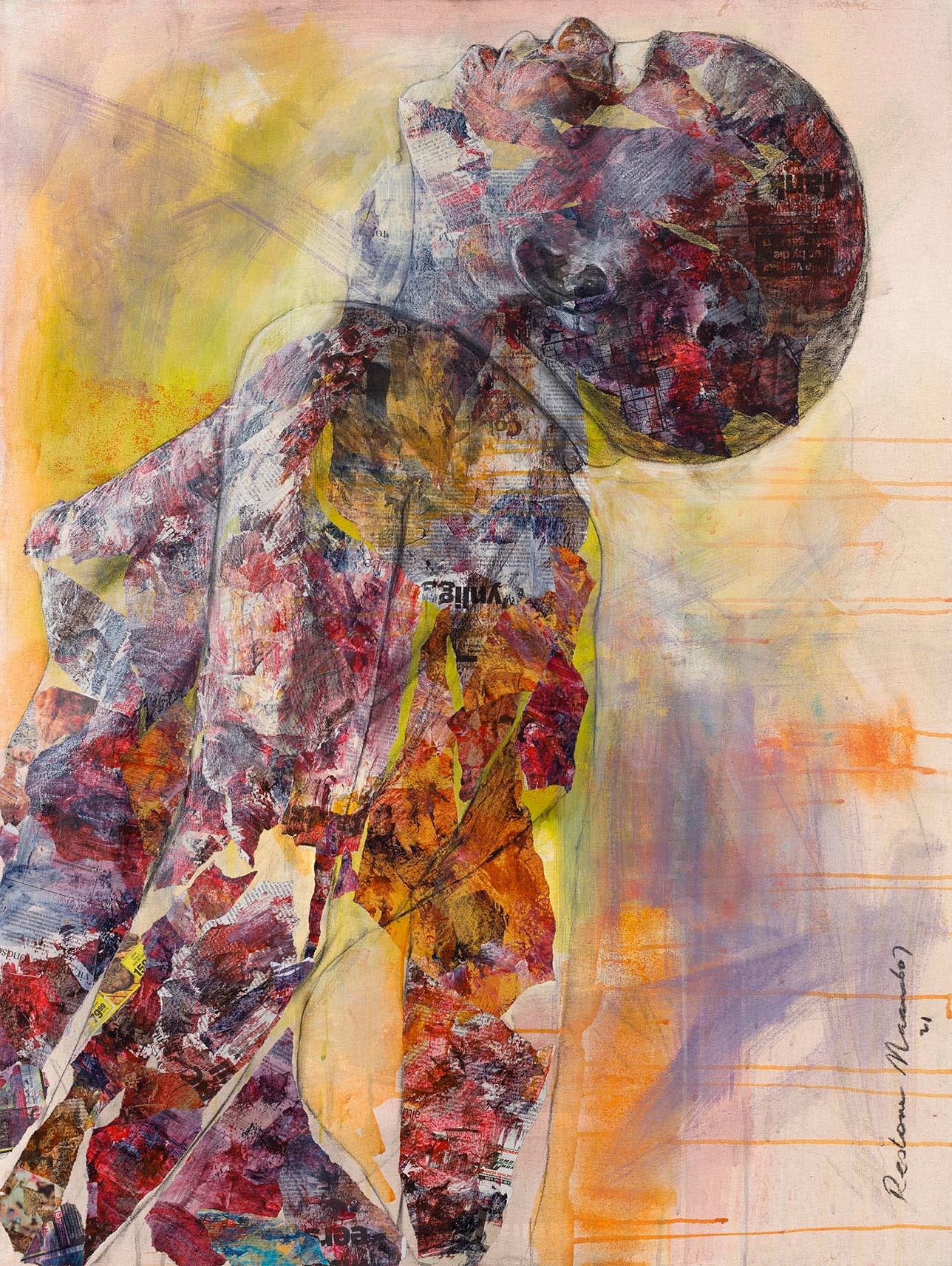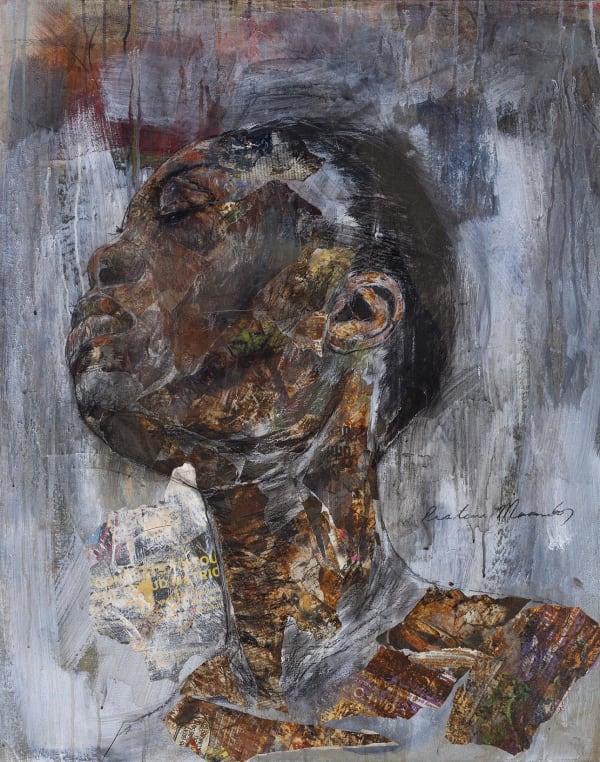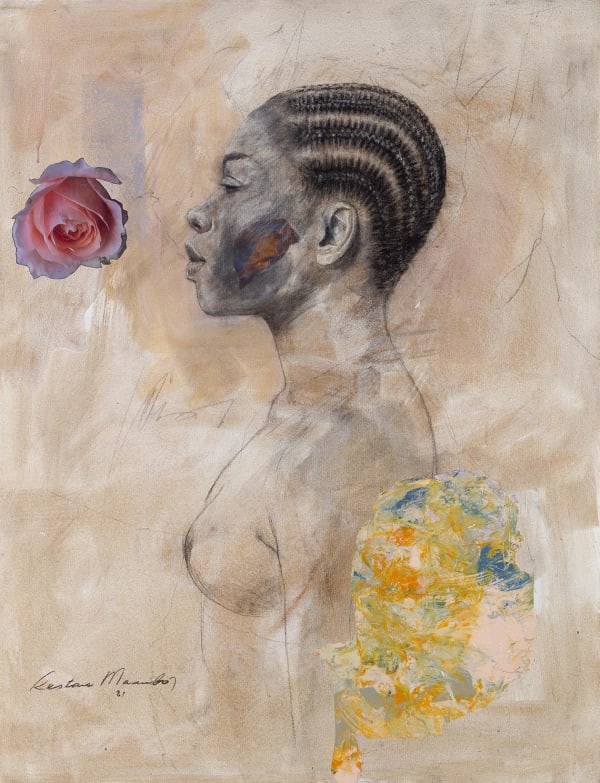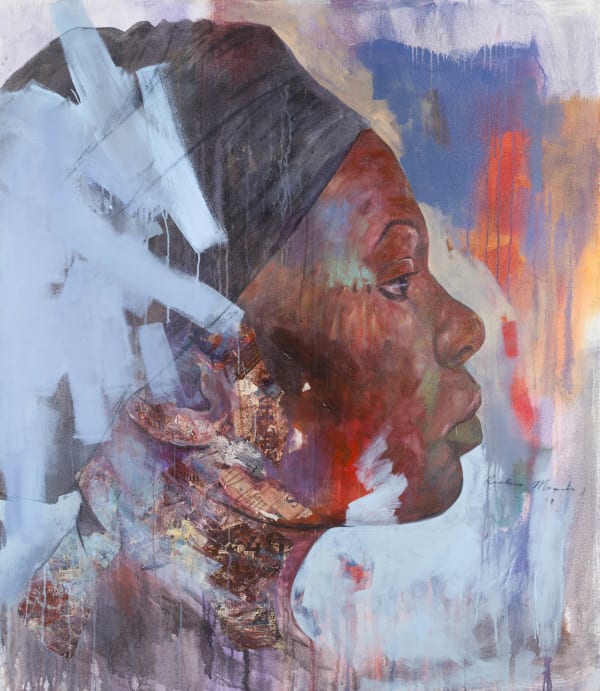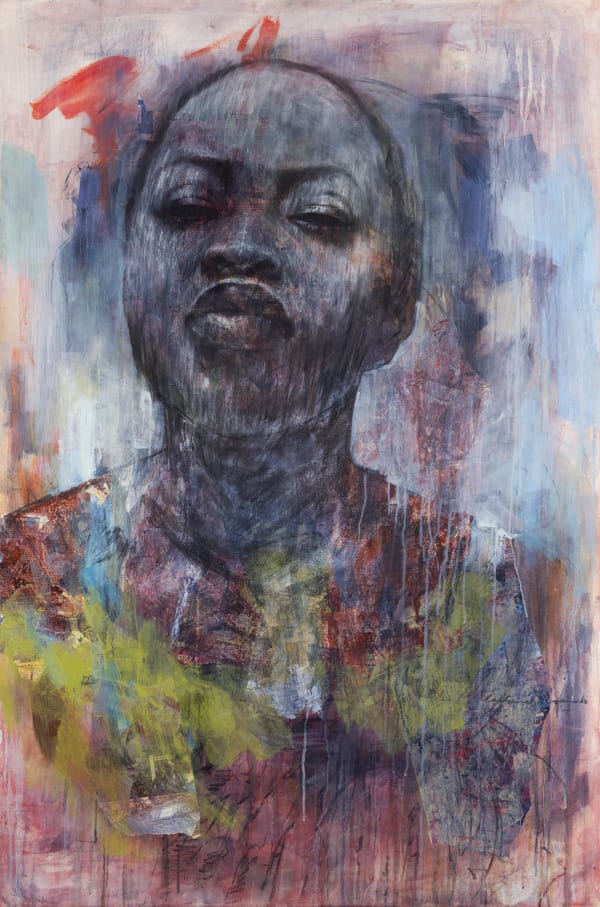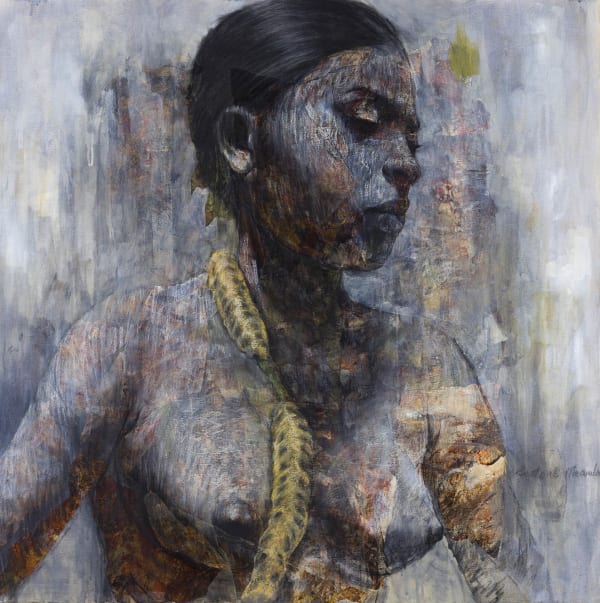In this exhibition, Maambo creates a space that does not isolate but rather highlights the intimacy of the spirit that resides within us all, not by confronting us with an image but by calling us to listen from within. Therefore, the gaze does not build a theory or language but rather a song or a spirit through the body of a woman, the ‘divine mother’ who Maambo calls upon us to remember.
-
About the artist
Restone MaamboMaambo creates a space that does not isolate but rather highlights the intimacy of the spirit that resides within us all
Restone Maambo navigates his ancestry and experiences with ‘Kusololwa Amumuni’, the call from the ancestors to become a sangoma or spiritual healer, through his artistic practice.
Traditional healers are considered to be the safeguards of tradition and culture and despite his decision to follow his passion for art rather than to become a spiritual healer, this is something that he takes very seriously.Perhaps it is the innate spirituality that the elders recognised in Restone at an early age that gives his paintings their unique almost meditative and healing quality that captivates the viewer.Restone was brought up by his mother and his respect and appreciation of femininity and womanhood stems from this positive relationship and features strongly in his works. He often paints woman in what appears to be a spiritual meditative state and the viewer feels touched to have been included into what is a very intimate and personal moment.Symbols and subject matter from every day life, and images inspired from the Old Testament interact with the sacred traditions and ceremonies of his ancestors creating an inimitable artistic interpretation of his life in Zambia and what lies beyond it. His artworks are created using acrylic impasto paint, varnish layering, collage and mixed media which are often applied to large canvases. Restone has participated in numerous exhibitions throughout Africa and abroad. He is swiftly developing a strong global collectors base.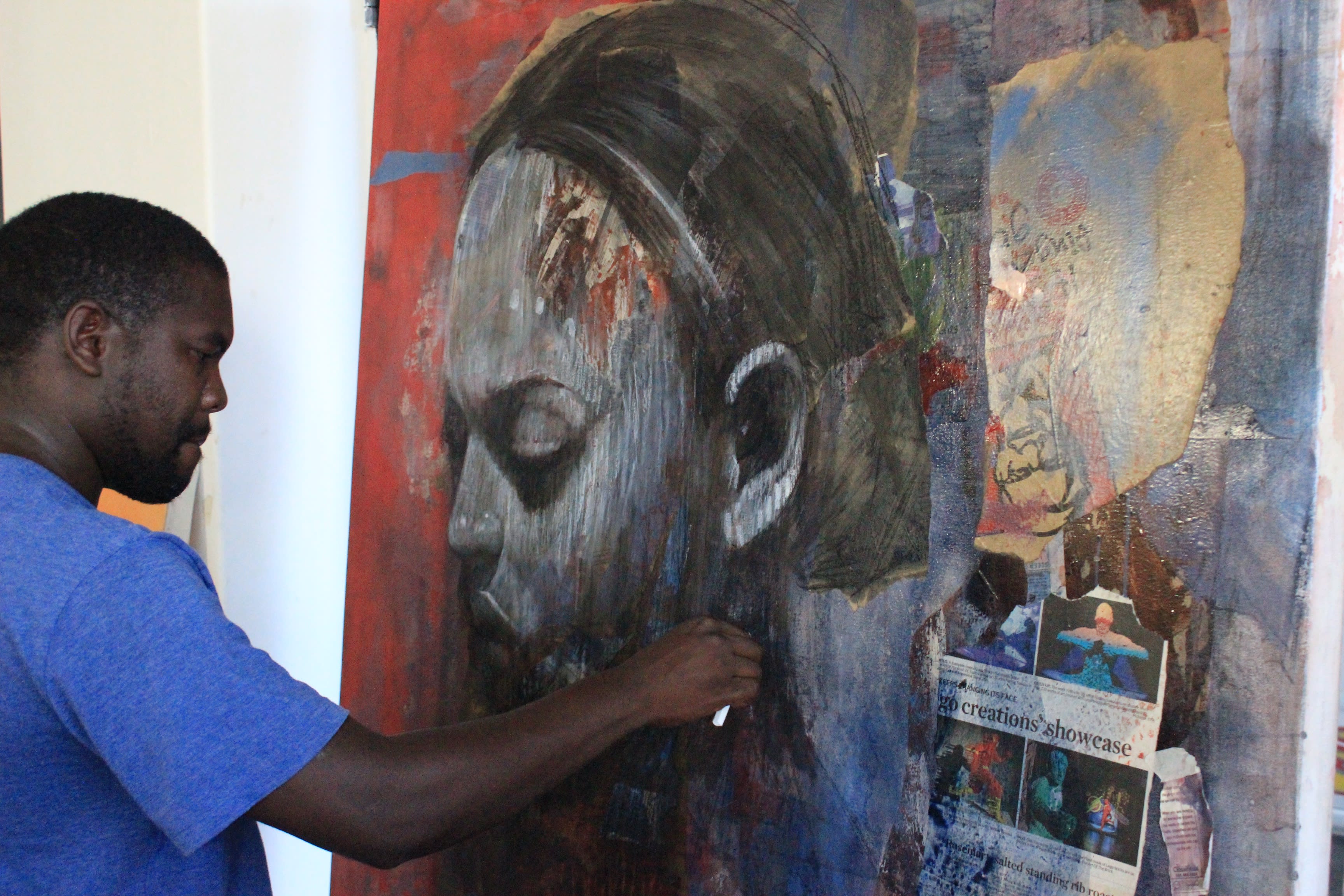
-
 Restone MaamboEntering The Ancestors, 2021Collage and pastel on canvas160 x 200 cmSold
Restone MaamboEntering The Ancestors, 2021Collage and pastel on canvas160 x 200 cmSold -
Remember the Divine Mother
Curatorial statement by Ruzy RusikeRestone creates a space that does not isolate but rather highlights the intimate, historically violent narratives of the spirit that resides within us all. Not by confronting us with an image but by calling us to listen from within through the divine feminine.
The Artwork
We are born into consciousness through spirituality, and thereafter spirituality becomes the pillar of our being on which consciousness rests. Consciousness is the substance of masculine energy which dominates the physical realm, but there exist other realms, equally important. Feminine energy governs one of these alternate realms, the spiritual realm, and its substance is joy, whose essence is found in language, love and beauty.
In the physical world, society experiences a collective amnesia of the spiritual realm and its feminine authority. Consciousness overtakes all and sees power manifest as chaos and hate. This manifestation is a consequence of an imbalance in our essential energies. In his work, Restone Maambo embraces both, and advocates for the need of a balance between the two through the restoration of The Divine Mother.
This restoration is a task for our memory. As we all entered consciousness through the spirituality of feminine energy, we all possess it, but the bombardment of masculine energy has led us to forget. As we have forgotten, so has our ability to recognise it has been lost. To restore the divine balance, we are called by Maambo’s work and the sweet song of feminine divinity, not to choose a single identity, but to Remember the Divine Mother.
The forgetting of the feminine and restructuring for the masculine is a century’s old injustice as Morgan (2005) articulates:
“African women emerged in the sixteenth- and seventeenth-century imagination as monstrous and inhuman, thereby helping to justify the many faces of European colonialism (economic, political, cultural). Equally important, writers like Ligon were instrumental in carrying such images back to metropolitan centers like London, where readers who would never travel beyond their own shores could learn about the linkages being made between nonwhite sexuality and savagery and could participate in the colonial experience, however geographically distant.”
Morgan, J.L. (2005) Male Travelers, Female Bodies, and the Gendering of Racial Ideology, 1500-1770.
Economically, physical abundance was equated with capacity for labour. Politically it symbolised savagery. Culturally, it was nothing but monstrosity personified. All of these perceptions grounded in masculine energy, rooted in the physical realm. Who would not forget?
The black female body is thus a preeminent site of our collective memory loss, and this artwork showcases the same body as creator and nurturer. This forgotten body becomes the means through which we explore myth, fear, lust and sentimentality… the means through which we embrace our feminine energy. The breast becomes, embodied differently according to the history, class, creed and culture that surrounds it, is the emblem of our recollection.
The Artist
The seeds of Maambo’s profound respect and appreciation for the feminine energy and the contributions of womanhood to the world, were sewn in his own upbringing, caringly tended by his mother. These values are reflected in all his work, but for these specific images and figures we must look into the past – after all, isn’t that remembering? – to the Old Testament and Maambo’s sacred ancestral traditions and ceremonies which are woven and entwined in an inimitable artistic interpretation of his life in Zambia, and what lies beyond it.
Acrylic impasto paint, varnish layering, collage and mixed media are applied to large canvas to draw spirituality to the fore. Physical bodies are portrayed within the mapping of the landscapes, at once separate but inseparable. Together these elements create an artwork, but also a transcendent spiritual experience. When you are called to Remember the Divine Mother, your attendance is being requested in a realm that pre-exists your consciousness. Occupation of this realm requires a provocation of the relationship between psychoanalysis and maternal care.
Describing his own work, Maambo states:
“The overall idea of my work is an exercise to my mind as there is no denying the huge role the spiritual world and activities exist. I have tried to express part of that in my work by choosing culture practices, meditations, levitation, beliefs etc. Being a Christian, I have also used this concept because we worship what we don't see with naked eyes. This is because our body covers our eyes from what we can't see and there comes the spiritual world. Beliefs can be choices and experience, but the spiritual world has arrived.”
Provoke your spirit. Answer the call. Remember.
-
Umemumelo (coming of age)
-
 Restone MaamboBashibukombe, 2021Collage and pastel on canvas200 x 170 cmR 160,000.01
Restone MaamboBashibukombe, 2021Collage and pastel on canvas200 x 170 cmR 160,000.01 -
 Restone MaamboCommemoration of the Ancestors, 2019Collage and mixed media on canvas95 x 180 cmSold
Restone MaamboCommemoration of the Ancestors, 2019Collage and mixed media on canvas95 x 180 cmSold -
 Restone MaamboUmemumelo III, 2021Collage and pastel on canvas150 x 160 cmR 140,000.00
Restone MaamboUmemumelo III, 2021Collage and pastel on canvas150 x 160 cmR 140,000.00 -
She is "spirit" and "earth" at once
-
 Restone MaamboCalled separately, 2021Collage and pastel on canvas180 x 150 cmR 150,000.00
Restone MaamboCalled separately, 2021Collage and pastel on canvas180 x 150 cmR 150,000.00 -
To begin, we must embark on a journey of deconstruction, spanning a long history of injustice, separating the black female body from the corrupt perceptions that consciousness has imprinted upon it. This body, as creator and nurturer, must be reclaimed from its colonial economic, political and cultural perversions. Thus, the most appropriate emblem for the quest for feminine energy is the breast, embodied according to the history, class, creed and culture that surrounds it. - Ruzy Rusike
-
The figures are often placed at curious angles, seemingly defying gravity. They fill the space in ways that often suggests flight; at other times they simply gesture in poses that point to an awareness of the spiritual - Danny Shorkend - Danny Shorkend
-
 Restone MaamboDaybreak, 2021Collage and pastel on canvas130,5 x 90 cmR 100,000.00
Restone MaamboDaybreak, 2021Collage and pastel on canvas130,5 x 90 cmR 100,000.00 -
Isanusi or Seer (Diviners)
-
 Restone MaamboSeer, 2021Collage and pastel on canvas200 x 171 cmR 160,000.01
Restone MaamboSeer, 2021Collage and pastel on canvas200 x 171 cmR 160,000.01 -
 Restone MaamboOfferings, 2021Collage and pastel on canvas180 x 130 cmR 140,000.00
Restone MaamboOfferings, 2021Collage and pastel on canvas180 x 130 cmR 140,000.00 -
 Restone MaamboA State of Being , 2021Collage and pastel on canvas180 x 130 cmR 140,000.00
Restone MaamboA State of Being , 2021Collage and pastel on canvas180 x 130 cmR 140,000.00 -
The hum of the mother's spirit
-
 Restone MaamboA Mother Cannot Die, 2021Collage and pastel on canvas149 x 99 cmR 115,000.00
Restone MaamboA Mother Cannot Die, 2021Collage and pastel on canvas149 x 99 cmR 115,000.00 -
 Restone MaamboIkuzumina (Accepting The Call), 2021Collage and pastel on canvas180 x 130 cmSold
Restone MaamboIkuzumina (Accepting The Call), 2021Collage and pastel on canvas180 x 130 cmSold -
We are born into consciousness through spirituality, and thereafter spirituality becomes the pillar of our being on which consciousness rests. Consciousness is the substance of masculine energy which dominates the physical realm, but there exist other realms, equally important. Feminine energy governs one of these alternate realms, the spiritual realm, and its substance is joy, whose essence is found in language, love and beauty. - Ruzy Rusike
-
Claiming a territory within
-
 Restone MaamboI Am My Soul, 2021Collage and pastel on canvas122 x 91 cmR 90,000.00
Restone MaamboI Am My Soul, 2021Collage and pastel on canvas122 x 91 cmR 90,000.00 -
In studio
-
-
Acrylic impasto paint, varnish layering, collage and mixed media are applied to large canvas to draw spirituality to the fore. Physical bodies are portrayed within the mapping of the landscapes, at once separate but inseparable. Together these elements create an artwork, but also a transcendent spiritual experience. When you are called to Remember the Divine Mother, your attendance is being requested in a realm that pre-exists your consciousness. Occupation of this realm requires a provocation of the relationship between psychoanalysis and maternal care.
-
Provoke your spirit. Answer the call. Remember. - Ruzy Rusike

